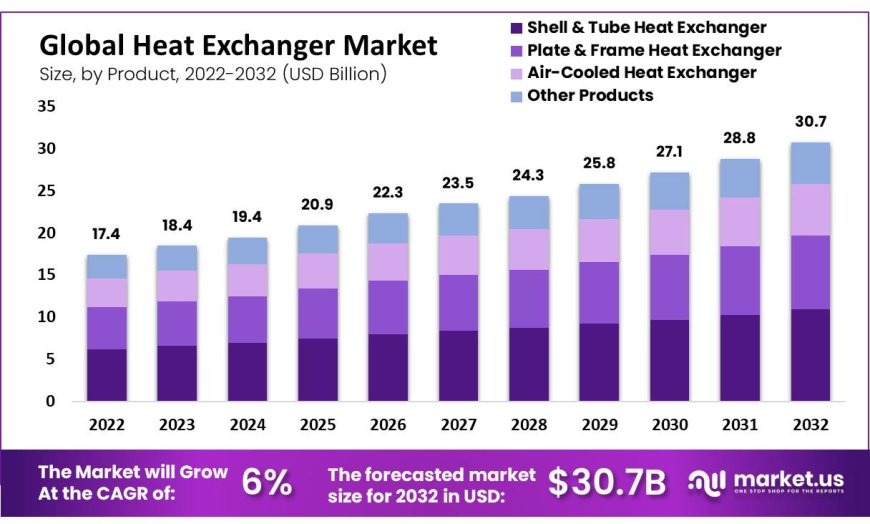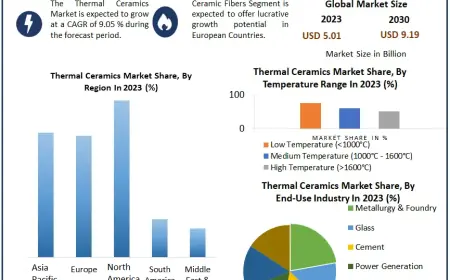Heat Exchanger Market i 2023 Key Players, Industry Size, Share, Segmentation, Comprehensive Analysis and Forecast by 2032
The global heat exchanger market size is expected to experience compound annual growth rate from 2023-2032 at a rate of 6% from 2022-2032, rising from USD 17.4 Billion in 2022 to USD 30.7 Billion by 2032.

Market Overview
The global Heat Exchanger Market is expected to experience steady growth over the coming years, driven by rising demands for energy efficiency and environmental protection across various industries. Asia Pacific region is projected to experience rapid expansion as a market for heat exchangers during this forecast period.
The global heat exchanger market size is expected to experience compound annual growth rate from 2023-2032 at a rate of 6% from 2022-2032, rising from USD 17.4 Billion in 2022 to USD 30.7 Billion by 2032.
Download a complimentary PDF sample of our in-depth report: https://market.us/report/heat-exchanger-market/request-sample/
Heat Exchanger Market Dynamics:
Key Developments in Heat Exchanger Market:
An increase in energy-efficient solutions: Heat exchangers play a crucial role in numerous applications that rely on energy, including power generation, oil and gas processing and chemical manufacturing. As these industries seek to minimize environmental impact and operating costs while remaining cost competitive they have begun turning more often towards energy-efficient heat exchangers as a solution - creating significant growth for energy-efficient heat exchanger sales over the coming years.
Technological Advancements: Technological advancements have led to the creation of new and improved heat exchanger designs. New materials and manufacturing processes enable more energy-efficient, corrosion-resistant heat exchangers. Furthermore, advances in heat exchanger design software help engineers design more optimal solutions for individual applications.
Renewable Energy Adoption: As renewable energy sources such as solar and wind power become more widely adopted, their increasing adoption has also fuelled an increased need for heat exchangers. Intermittent sources like these require heat exchangers in order to store thermal energy when producing power, then release it when not.
Increased Collaboration Between Heat Exchanger Manufacturers and End Users: Heat exchanger manufacturers are increasingly working closely with end users to design custom heat exchanger solutions tailored to their applications, helping drive innovation within the heat exchanger market.
Heat Exchanger Market Trends Analysis:
Rising Demand for Energy Efficiency: Heat exchangers have become essential tools in increasing energy efficiency in numerous industries such as power generation, chemical processing, food and beverage processing and HVAC&R systems - due to rising energy costs as well as government regulations to reduce greenhouse gas emissions. This trend is being propelled by rising energy costs as well as legislation mandating greenhouse gas reduction measures.
Increased Adoption of Renewable Energy: As more renewable sources such as solar and wind power become increasingly widespread, their intermittent nature requires efficient energy storage solutions such as heat exchangers. Heat exchangers play an essential part here by providing thermal energy storage when renewable resources are unavailable for use.
Demand from Emerging Markets: Asia and Africa are experiencing unprecedented rates of industrialization and urbanization, driving demand for heat exchangers in a range of industries such as power generation, oil & gas exploration & production and chemical processing.
Technological Advancements: Heat exchanger manufacturers are constantly innovating new technologies to increase performance, efficiency and reliability in their products. Innovation areas include developing new materials, manufacturing processes and design concepts.
Heat Exchanger Market Breakthroughs:
Materials advancement: is providing the foundation for more efficient and durable heat exchangers - for example graphene enhanced exchangers may even increase efficiency by as much as 50 %!
Manufacturing innovations: Thanks to new manufacturing processes, heat exchangers featuring more complex designs can now be produced more cost effectively and efficiently resulting in smaller heat exchangers which are lighter weight and more compact in design.
Heat exchangers are increasingly being fitted with sensors and control: that allow real-time monitoring and optimization of performance, which can improve efficiency, decrease costs and extend lifespan of heat exchangers.
Microchannel heat exchangers have revolutionized heat transfer efficiency: Utilizing a network of microscopic channels to transfer heat, these small exchangers can efficiently transfer it without using up too much space in their compact designs. Already these exchangers are used widely across industries including electronics cooling, automotive HVAC and aerospace applications.
Heat Exchanger Market Report Highlights:
Heat Exchanger Market Report Highlights: Expanding Industrialization: Rising industrialization in developing nations has increased demand for point-to-point heat exchangers used across various industries such as chemicals, petrochemicals and food and beverage production.
Renewable Energy Adoption: Solar and wind power can be unpredictable sources of power; point-to-point heat exchangers can help make them more reliable and efficient by storing and dissipating thermal energy efficiently from these intermittent sources.
Demand for Energy Efficiency: Point-to-point heat exchangers have become an indispensable solution to improving energy efficiency by recovering and reusing heat that would otherwise go to waste, making a big impactful statement about business' and governments' commitments to reducing their environmental footprint while cutting energy costs.
Technology Advancements: Over time, technological innovations in materials and design technologies have resulted in more cost-effective point to point heat exchangers that feature enhancements of heat transfer surface enhancement, compact designs, corrosion-resistant materials and innovations that improve cost-efficiency and performance.
Key Market Segments
Based on Product
- Shell & Tube Heat Exchanger
- Plate & Frame Heat Exchanger
- Brazed Plate & Frame Heat Exchanger
- Gasketed Plate & Frame Heat Exchanger
- Welded Plate and frame Heat Exchanger
- Others
- Air-Cooled Heat Exchanger
- Other Products
Based on the Material of Construction
- Stainless Steel
- Copper
- Aluminum
- Other Materials
Based on End-User
- Chemical & Petrochemical
- Oil & Gas
- HVAC & Refrigeration
- Power Generation
- Food & Beverage
- Pulp & Paper
- Other End-Users
Market Key Players
- Alfa Laval AB
- Kelvion Holding GmbH
- Danfoss A/S
- API Heat Transfer Inc.
- Xylem Inc.
- HRS Heat Exchangers Ltd.
- Hisaka Works, Ltd.
- Koch Heat Transfer Company
- GEA Group AG
- SWEP International AB
- Thermax Limited
- Tranter, Inc.
- Other Key Players
Contact us
Global Business Development Team: Market.us
Market.us (Powered By Prudor Pvt. Ltd.)
Send Email: inquiry@market.us
Address: 420 Lexington Avenue, Suite 300 New York City, NY 10170, United States
Tel: +1 718 618 4351, +91 78878 22626
What's Your Reaction?
 Like
0
Like
0
 Dislike
0
Dislike
0
 Love
0
Love
0
 Funny
0
Funny
0
 Angry
0
Angry
0
 Sad
0
Sad
0
 Wow
0
Wow
0











































